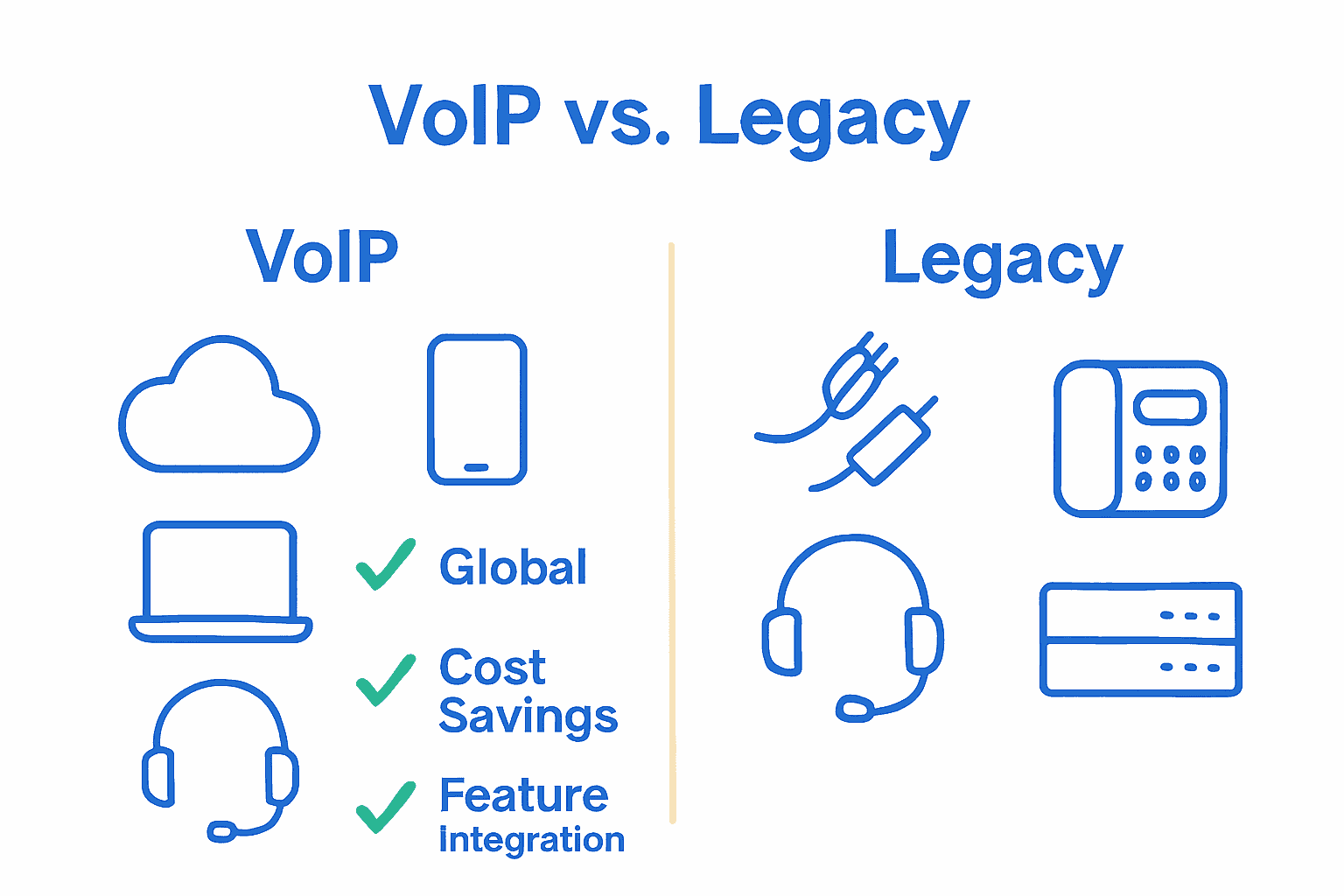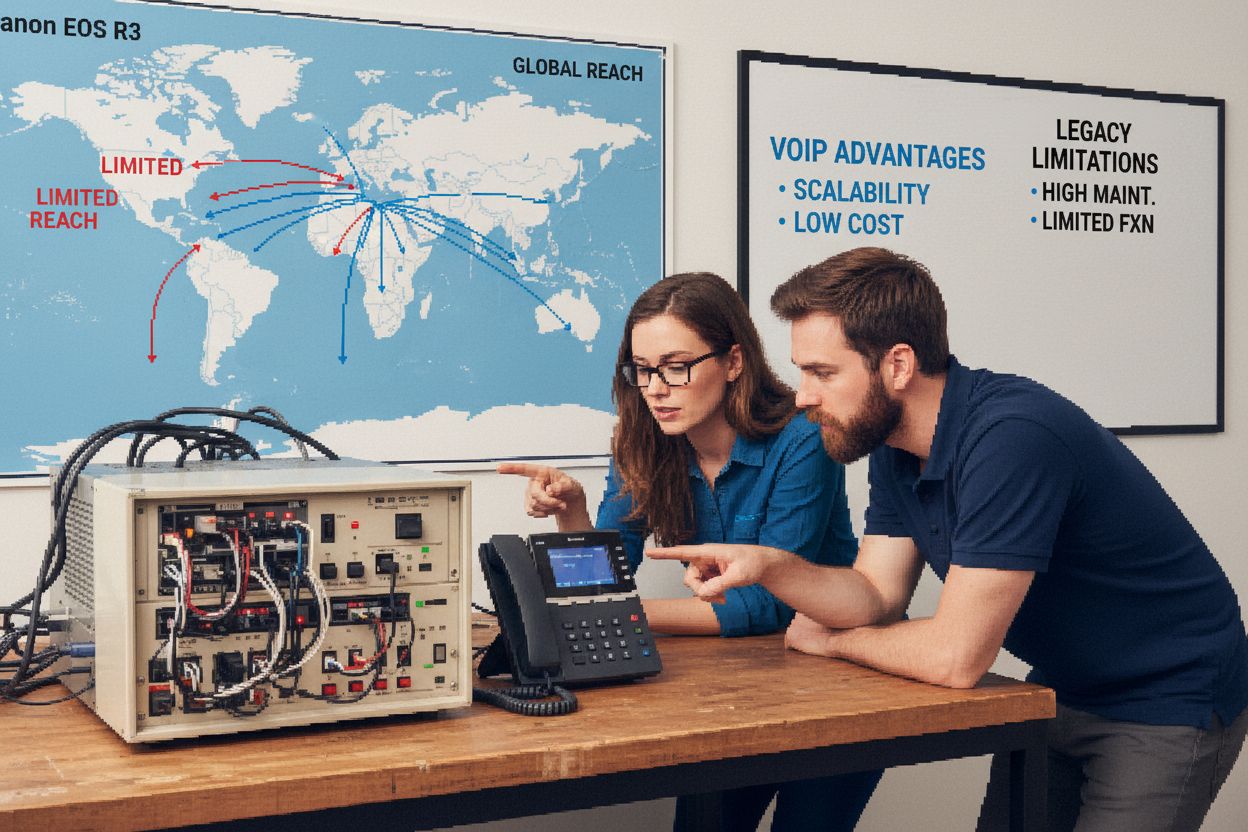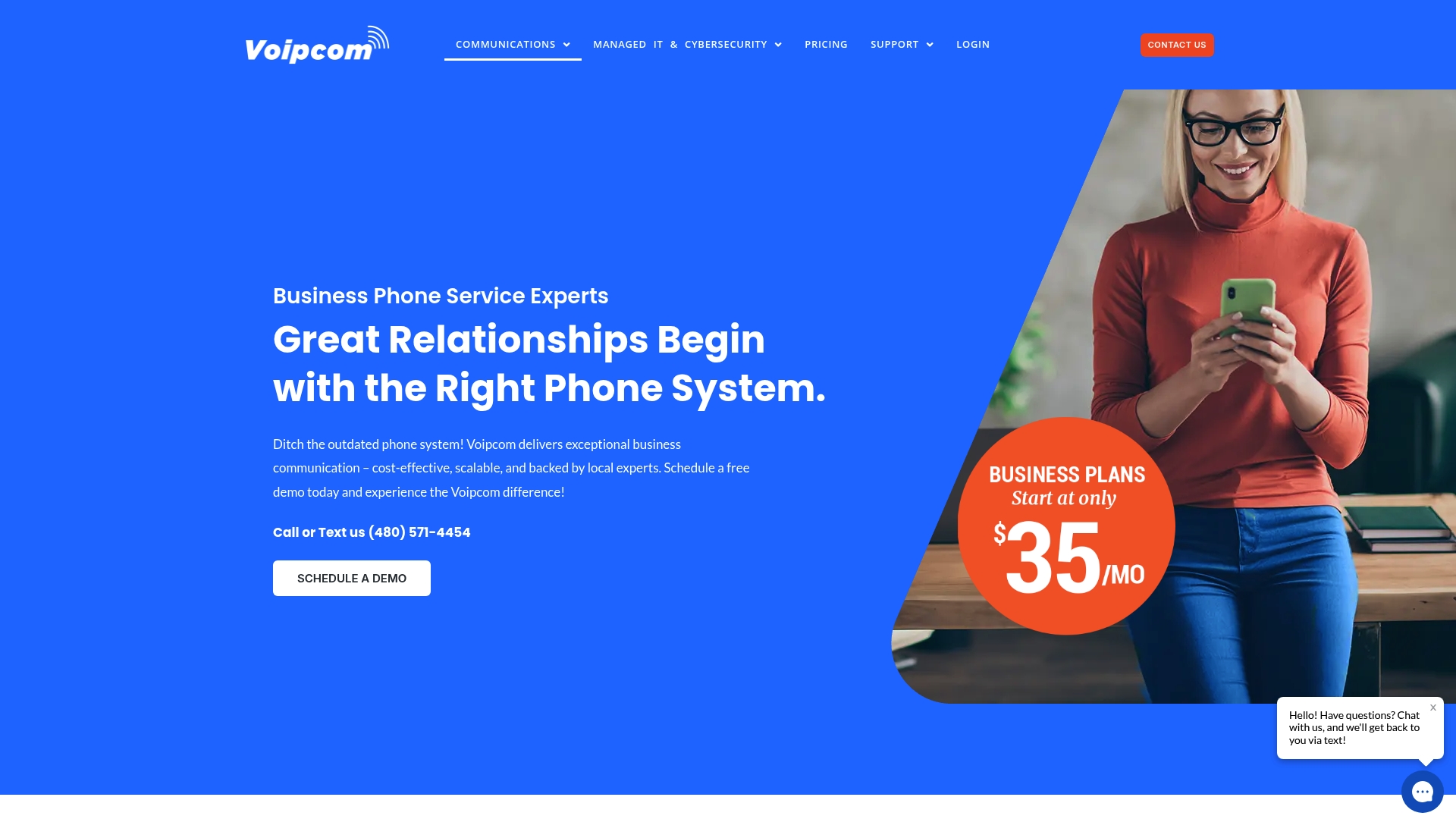Did you know that nearly 70% of businesses worldwide are shifting from legacy phone systems to VoIP solutions? This change is not just about adopting new technology but about gaining flexibility, lowering costs, and keeping up with evolving business needs. Understanding the core differences between VoIP and traditional phone lines helps organizations make smarter choices that improve daily communications and support long-term growth.
Key Takeaways
| Point | Details |
|---|---|
| VoIP vs Legacy Systems | VoIP technology offers substantial advantages over legacy systems, including lower costs, flexibility, and enhanced features. |
| Cost Savings | Transitioning to VoIP can reduce communication expenses by 30% to 75%, translating to significant savings per employee. |
| Migration Planning | Successful migration to VoIP requires strategic planning, ensuring network readiness and addressing potential technical challenges. |
| Operational Benefits | VoIP systems not only lower costs but also streamline business communication with integrated voice, video, and data capabilities. |
Table of Contents
- Defining Voip And Legacy Phone Systems
- Key Differences In Technology And Features
- Benefits And Drawbacks For Businesses
- Cost Analysis And Operational Impacts
- Migration Steps And Common Pitfalls
Defining VoIP and Legacy Phone Systems
Business communication technology has transformed dramatically, and understanding the difference between Voice over Internet Protocol (VoIP) and traditional legacy phone systems is crucial for modern organizations. According to research from the U.S. Congress, VoIP represents a revolutionary communication approach that rides on public or private data networks, enabling voice integration with data and video capabilities far beyond traditional circuit-switched telephony.
Traditional legacy phone systems operate through physical copper telephone lines, using circuit-switched technology that dedicates a specific communication channel for each call. These systems have served businesses for decades but come with significant limitations:
- High infrastructure maintenance costs
- Limited scalability
- Restricted geographic functionality
- Expensive long-distance calling rates
- Minimal additional communication features
In contrast, VoIP technology transforms voice communications into digital data packets transmitted over internet connections. This approach offers businesses unprecedented flexibility and functionality. Read our comprehensive guide on VoIP advantages to understand how modern communication systems can revolutionize your business operations. VoIP enables organizations to consolidate voice, video, and data communications through a single, integrated platform, dramatically reducing operational complexity and communication expenses.
Key Differences in Technology and Features
The technological landscape between legacy phone systems and VoIP represents a fundamental shift in communication infrastructure. According to congressional research, VoIP’s revolutionary approach enables software-driven enhancements that traditional phone systems simply cannot match, offering unprecedented flexibility in communication technology.
Technological differences between these systems are profound and far-reaching:
Here’s a comparison of VoIP and Legacy Phone Systems:
| Aspect | VoIP | Legacy Phone Systems |
|---|---|---|
| Infrastructure | Internet-based Uses existing data networks |
Copper phone lines Dedicated circuits |
| Scalability | Easy to expand Software-driven |
Limited Requires hardware upgrades |
| Features | Voice, video, data Advanced integrations |
Voice only Few extra features |
| Cost Structure | Lower monthly costs Minimal hardware |
Higher per-line fees Maintenance costs |
| Geographic Reach | Global Remote capability |
Local Restricted by wiring |
| Hardware | Minimal Softphones, headsets |
Complex PBX, desk phones |
- Infrastructure: Legacy systems rely on physical copper lines, while VoIP operates through internet protocols
- Scalability: VoIP can be rapidly expanded or modified through software updates
- Feature Integration: VoIP seamlessly incorporates video, messaging, and data communication
- Cost Structure: VoIP eliminates expensive per-line hardware and maintenance expenses
Hardware Requirements also dramatically differ between these communication technologies. Traditional phone systems demand dedicated physical infrastructure with complex, expensive hardware installations. VoIP, by contrast, operates through existing internet networks, allowing businesses to leverage current digital infrastructure.

Benefits and Drawbacks for Businesses
Business communication technology demands careful evaluation, and VoIP presents a compelling yet nuanced solution. According to research from tech industry analysis, switching from traditional legacy systems to VoIP can yield substantial financial advantages, with potential cost reductions ranging from 30% to 75% and estimated savings of $1,200 per employee annually.
Key Business Benefits of VoIP include:
- Dramatically lower communication expenses
- Flexible advanced call features
- Enhanced scalability and portability
- Seamless integration with modern digital workflows
- Reduced hardware maintenance costs
Potential Drawbacks must also be carefully considered. Explore our comprehensive communication solutions to understand how to mitigate these challenges. While VoIP offers tremendous advantages, businesses should be aware of potential limitations such as internet dependency, possible latency issues, and emergency calling (E911) complexities. Security vulnerabilities can emerge if proper network protections are not implemented, and hidden costs might surprise organizations without thorough initial planning. The key is selecting a robust VoIP provider that can address these potential challenges while delivering the significant operational and financial benefits modern businesses require.
Cost Analysis and Operational Impacts
Understanding the financial landscape of communication technologies is crucial for businesses seeking cost-effective solutions. According to industry research, hosted VoIP systems offer significantly more attractive pricing models compared to traditional analog phone systems, with costs ranging from $10–$40 per user monthly for small businesses and $25–$140 per user for larger organizations.
A detailed cost comparison reveals substantial financial advantages:
- Traditional Analog Systems:
- Line rental costs: ~$50/month per line
- Hardware costs: $150–$250 per phone
- Additional installation expenses
- VoIP Systems:
- Per-user monthly costs: $15–$40
- Included advanced features
- Potential savings up to 90%
Operational Impacts extend far beyond simple monetary savings. Learn more about our cost-effective communication strategies that can transform your business infrastructure. VoIP not only reduces direct communication expenses but also provides enhanced flexibility, scalability, and integrated features that traditional systems cannot match. By eliminating expensive hardware investments and reducing maintenance costs, businesses can redirect resources toward core strategic initiatives, creating a more agile and responsive organizational communication environment.
Migration Steps and Common Pitfalls
Successful VoIP migration requires strategic planning and a comprehensive understanding of potential challenges. According to industry research, organizations must carefully navigate technical complexities to ensure a smooth transition from traditional communication systems to modern internet-based solutions.
Key Migration Steps include:
- Assess current network infrastructure
- Evaluate bandwidth and internet connectivity
- Select a compatible VoIP provider
- Plan comprehensive employee training
- Develop a phased implementation strategy
Common Migration Challenges can significantly impact communication effectiveness. Explore our expert migration support services to mitigate potential risks. Research highlights critical pitfalls such as call-quality issues, including network jitter and latency, potential bandwidth limitations, and complex call routing configurations. Successful migration demands proactive strategies like implementing real-time monitoring systems, establishing robust Quality of Service (QoS) policies, negotiating strong Service Level Agreements (SLAs), and developing comprehensive redundancy plans to ensure uninterrupted business communication.
Ready to Leave Frustrating Legacy Phone Systems Behind?
If you are tired of high costs, limited features, or clunky old phone lines, your business is not alone. The article made it clear that outdated legacy systems can hold your organization back with expensive maintenance, poor scalability, and complicated hardware. Imagine the relief of connecting your entire team, in or out of the office, all while cutting costs and boosting productivity. Voipcom takes the pain and uncertainty out of migrating to modern VoIP by providing cloud-based communications, robust IT support, and seamless integrations that position your business for growth. Explore how our fully managed solutions overcome common migration pitfalls and bridge every gap raised in the VoIP Versus Legacy Phone Systems: Complete Guide.
Ready to simplify your communications and future-proof your business? Get transparent pricing, local support, and more features than you thought possible. Do not let network headaches or hidden fees slow you down. Act now by visiting Voipcom to discover how easy and affordable it is to upgrade. Your modern phone system is just a step away from transforming your business.
Frequently Asked Questions
What is the main difference between VoIP and legacy phone systems?
VoIP (Voice over Internet Protocol) uses the internet to transmit voice data, while legacy phone systems rely on physical copper lines and circuit-switched technology. This fundamental difference allows VoIP to integrate voice, video, and data communications seamlessly.
What are the cost advantages of using VoIP over legacy phone systems?
VoIP typically offers lower monthly costs, with potential savings ranging from 30% to 75% compared to traditional legacy systems. Costs can be as low as $10–$40 per user monthly for small businesses, whereas traditional systems often incur high line rental and hardware costs.
How can businesses ensure a smooth migration from legacy systems to VoIP?
To ensure a successful migration, businesses should assess their current network infrastructure, evaluate bandwidth and internet connectivity, select a compatible VoIP provider, plan employee training, and develop a phased implementation strategy to address any potential challenges.
What are some common challenges associated with VoIP implementation?
Common challenges include call quality issues (such as latency and jitter), bandwidth limitations, and complex call routing. Businesses should implement monitoring systems and establish Quality of Service (QoS) policies to mitigate these risks.




